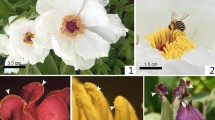Abstract
Characteristics of phytin storage in mature flax seeds, namely, concentration range, effect of weather and climatic conditions of the vegetation period, and morphology and size of phytate globoids in aleurone grains, have been determined. The content of phytic acid in flax seeds harvested in 2005–2009 ranged from 29.3 to 35.4 g/kg. High amounts of precipitation and low average daily temperature during seed ripening promoted accumulation of large amounts of phytin in seeds. Scanning electron microscopy showed that phytin globoids in the storage parenchyma of flax cotyledons are electron-dense spherical concretions ranging from 2.3 to 5.6 μm in diameter. Element composition analysis showed that phytic acid salts from flax contained K, Mg, Mn, Ca, and Fe.
Similar content being viewed by others
References
Rubilar, M., Gutiérrez, C., Verdugo, M., et al., Flaxseed as a source of functional ingredients, J. Soil. Sci. Plant Nutr., 2010, vol. 10, no. 3, pp. 373–377.
Bhatty, R.S. and Cherdkiatgumchai, P., Compositional analysis of laboratory-prepared and commercial samples of linseed meal and of hull isolated from flax, J. Am. Oil Chem. Soc., 1990, vol. 67, no. 2, pp. 79–84.
Greenwood, J.S. and Bewley, J.D., Subcellular distribution of phytin in the endosperm of developing castor bean: a possibility for its synthesis in the cytoplasm prior to deposition within protein bodies, Planta, 1984, vol. 160, no. 2, pp. 113–120.
Graf, E., Empson, K.L., and Eaton, J.W., Phytic acid: a natural antioxidant, J. Biol. Chem., 1987, vol. 262, no. 24, pp. 11647–11650.
Raboy, V., Accumulation and storage of phosphate and minerals, Adv. Cell. Mol. Biol., 1997, vol. 4, p. 441.
York, J.D., Odom, A.R., Murphy, R., et al., A phospholipase c-dependent inositol polyphosphate kinase pathway required for efficient messenger rna export, Science, 1999, vol. 285, no. 5424, pp. 96–100.
Sasakawa, N., Sharif, M., and Hanley, M.R., Metabolism and biological activities of inositol pentakisphosphate and inositol hexakisphosphate, Biochem. Pharm., 1995, vol. 50, no. 2, pp. 137–146.
Voglmaier, S.M., Keen, J.H., Murphy, J.E., et al., Inositol hexakisphosphate receptor identified as the clathrin assembly protein AP-2, Biochem. Biophys. Res. Commun., 1992, vol. 187, no. 1, pp. 158–163.
Raboy, V., Gerbasi, P.F., Young, K.A., et al., Origin and seed phenotype of maize low phytic acid 1-1 and low phytic acid 2-1, Plant Physiol., 2000, vol. 124, no. 1, pp. 355–368.
Kirkbright, G.F. and Sargent, M., Atomic Absorption and Fluorescence Spectroscopy, New York: Academic, 1974.
Latta, M. and Eskin, M.A., Simple and rapid colorimetric method for phytate determination, J. Agricult. Food Chem., 1980, vol. 28, no. 6, pp. 1313–1315.
Ermakov, A.I., Arasimovich, V.V., and Smirnova-Ikonnikova, M.I., Metody biokhimicheskikh issledovanii rastenii (Methods of Biochemical Studies of Plants), Leningrad: Kolos, 1972.
Ivanter, E.V. and Korosov, A.V., Elementarnaya biometriya: Ucheb. Posobie (Elementary Biometrics: A Textbook), Petrozavodsk, 2010.
Diederichsen, A. and Richards, K., Cultivated flax and the genus Linum L. Taxonomy and germplasm conservation, in Flax: The Genus Linum, Muir, A.D. and Westcott, N.D., Eds., CRC Press, 2003, pp. 22–54.
Wiesnerová, D. and Wiesner, I., Computer image analysis of seed shape and seed color for flax cultivar description, Comp. Electron. Agricult., 2008, vol. 61, no. 2, pp. 126–135.
Shcherbakov, V.G. and Lobanov, V.G., Biokhimiya i tovarovedenie maslichnogo syr’ya (Biochemistry and Oilseed Merchandising), Moscow: Kolos, 2003.
Reddy, M.B., Hurrell, R.F., Juillerat, M.A., and Cook, J.D., The influence of different protein sources on phytate inhibition of nonheme-iron absorption in humans, Am. J. Clin. Nutr., 1996, vol. 63, no. 2, pp. 203–207.
Oomah, B.D., Kenschuk, E.O., and Mazza, G., Phytic acid content of flaxseed as influenced by cultivar, growing season, and location, J. Agric. Food Chem., 1996, vol. 44, no. 9, pp. 2663–2666.
Joyce, C., Deneau, A., Peterson, K., et al., The concentrations and distributions of phytic acid phosphorus and other mineral nutrients in wild-type and low phytic acid Js-12-LPA wheat (Triticum aestivum) grain parts, Can. J. Bot., 2005, vol. 83, no. 12, pp. 1599–1607.
Torres, J., Domínguez, S., Cerdá, M.F., et al., Solution behaviour of myo-inositol hexakisphosphate in the presence of multivalent cations, prediction of a neutral pentamagnesium species under cytosolic/nuclear conditions, J. Inorg. Biochem., 2005, vol. 99, no. 3, pp. 828–840.
Maddaiah, V.T., Kurnick, A.A., and Reid, B.L., Phytic acid studies, Proc. Soc. Exp. Biol. Med., 1964, no. 2, pp. 391–393.
Bohn, L., Josefsen, L., Meyer, A.S., and Rasmussen, S.K., Quantitative analysis of phytate globoids isolated from wheat bran and characterization of their sequential dephosphorylation by wheat phytase, J. Agric. Food Chem., 2007, vol. 55, no. 18, pp. 7547–7552.
Moroghan, J.T., Accumulation of cadmium and selected elements in flax seed grown on a calcareous soil, Plant Soil, 1993, vol. 150, no. 1, pp. 61–68.
Wikoffa, L. and Morahgana, J.T., Different iron/manganese relationships in two flax cultivars, J. Plant Nutr., 1986, vol. 9, no. 37, pp. 839–849.
Author information
Authors and Affiliations
Corresponding author
Additional information
Original Russian Text © V.V. Titok, S.I. Vakula, V.N. Leontiev, V.G. Lugin, 2015, published in Tsitologiya i Genetika, 2015, Vol. 49, No. 1, pp. 40–44.
About this article
Cite this article
Titok, V.V., Vakula, S.I., Leontiev, V.N. et al. Analysis of structural and qualitative features of phytin deposition in ripe flax seeds. Cytol. Genet. 49, 32–35 (2015). https://doi.org/10.3103/S0095452715010119
Received:
Published:
Issue Date:
DOI: https://doi.org/10.3103/S0095452715010119




